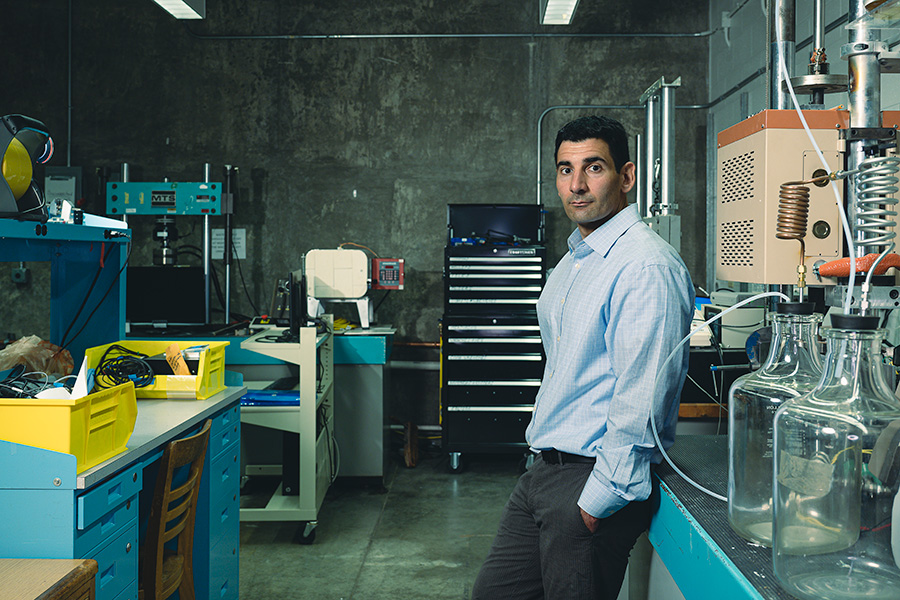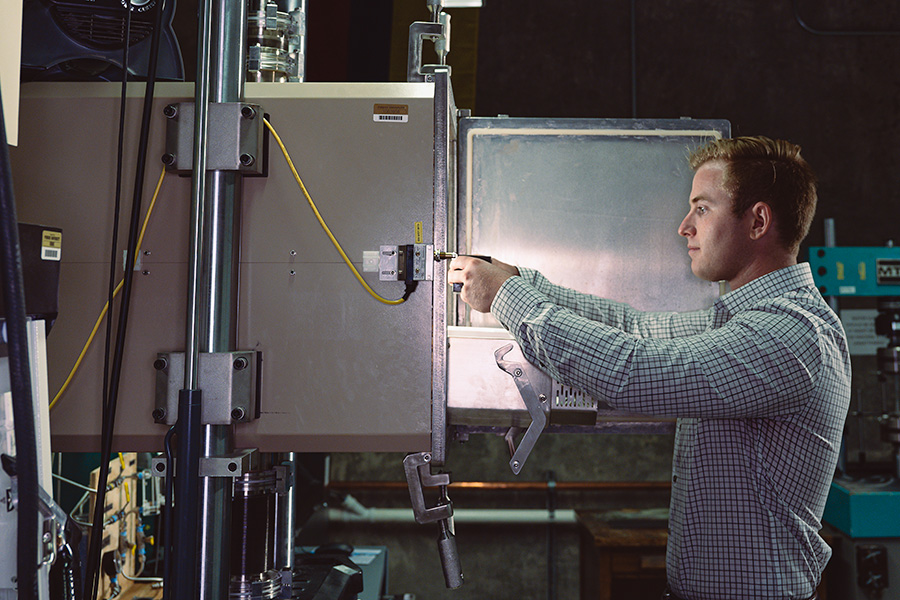
The new Hypersonics Advanced Manufacturing Technology Center (HAMTC) at Purdue will generate materials and manufacturing solutions in hypersonics that bridge the costly "valley of death."
"At a university setting there’s a lot of fantastic research, but that doesn’t mean it’s in a position where industry can readily use it. So most research is matured within a university and then it dies in the valley of death," says Michael Sangid, executive director of HAMTC and professor of aeronautics and astronautics.
One of the challenges in bridging this valley is the cost of integrating innovation into existing product lines and processes. Because companies want to shield their R&D efforts from their competitors — and the Department of Defense from its near peer adversaries — researchers often have to work on simplified versions of the problems manufacturers are trying to solve. They don’t often get to see full product specifications or how industry is hoping to implement those solutions.
HAMTC is different. Operating under the Purdue Applied Research Institute (PARI), which reports to the Purdue Board of Trustees, researchers can directly tackle the challenges faced in industry.
"PARI has enabled us to do more secured and classified research that couldn’t normally be done under the umbrella of Purdue, which has uniform guidance for all its contracts," Sangid says. "We can work closer with our industrial partners and our DOD customers, and that’s really what enables the vertical integration. We can design, build, join and test, all in the same facility, and conduct each of those steps directly with industrial partners."
The vertically integrated approach means incorporating new materials into vehicle designs, developing the unique manufacturing processes to realize these designs, joining discrete components together into subassemblies, and providing the test infrastructure to understand reliability in hypersonic environments. For each project in HAMTC there is also a digital twin of the physical prototype that aims to accurately predict future performance.
"We’re working on the entire process as opposed to a small piece," Sangid says. "There’s no need for somebody later to integrate all the pieces or scale the solutions."

Michael Sangid, Executive director of HAMTC and professor of Aeronautics and Astronautics
HAMTC will be housed within the new Hypersonic Aerospace Research Facility (HARF) being constructed at the Maurice J. Zucrow Laboratories (see sidebar). Placing HAMTC inside a hypersonics facility is no coincidence.
"The most pressing aspect we’re dealing with is the national need for increased capability for hypersonics. We can make a difference at the national scale," Sangid says.
Though this building won’t open officially until the spring of 2023, Sangid has already established partnerships with GE Additive, Dynetics, Lockheed Martin, Aerojet Rocketdyne, GE Edison Works, The Boeing Company and several small businesses.
"PARI has enabled us to do more secured and classified research that couldn't normally be done under the umbrella of Purdue."
–Michael Sangid, executive director of HAMTC
These companies are already gaining access to Purdue’s expertise in aerospace metals, ceramics and composites, including additive manufacturing of those materials.
"There’s really a materials and manufacturing push here," Sangid says. "We offer machines that can manufacture pieces that are to scale, with the fewest defects, and with as high dimensional precision as possible. At the same time, we are producing new materials that can be printed from those machines."
Chris Schuppe, general manager of engineering and technology at GE Additive, says this kind of industry-academia partnership is valuable to industrializing additive manufacturing.
"The potential for additive manufacturing in hypersonics is huge," Schuppe says. "We are honored to be part of Purdue’s team supporting the Department of Defense in manufacturing research that will advance U.S. national security and competitiveness. Our team, many of whom are Purdue alums, is excited to get started."

John Ferguson, a graduate student in aeronautics and astronautics, is part of the team working to generate materials and manufacturing solutions in hypersonics that bridge the costly "valley of death."
Purdue’s Hypersonic and Applied Research Facility (HARF) represents a $41 million investment by the university and its supporters to enhance its research capabilities in aerospace. When completed in spring of 2023, the 65,000-square-foot building will be home to HAMTC, as well as a hypersonic pulse shock tunnel, and the only Mach 8 quiet wind tunnel in the world.
Dave Schweikle (BSAAE ’59) was the first donor to take advantage of naming opportunities within HARF. The Dave Schweikle Aero Astro Lab will be HAMTC’s home, and accounts for about one-third the footprint of HARF. Additional naming gifts contributing to HARF have come from: Bob Strickler (BSAAE ’60, MSAAE ’62, PhD ME ’68) and Mary Strickler; Mike Corso (BSAAE ’71) and Sandi Corso (BS Sociology, ’71); Rick Weaver (BS ChemE, ’65) and Rita Weaver; and Doug Bowers (BSAAE ’72) and Jill Bowers.
"The HARF facility will bring incredible and unique capabilities to Purdue, but no undertaking of this size can be done alone," says Bill Crossley, the J. William Uhrig and Anastasia Vournas Head of the School of Aeronautics and Astronautics. "These gifts will have a profound impact on the work done within HARF, and the school as a whole. The research done within the facility with the help of these gifts will allow Purdue to continue to be a leader in hypersonic technologies."